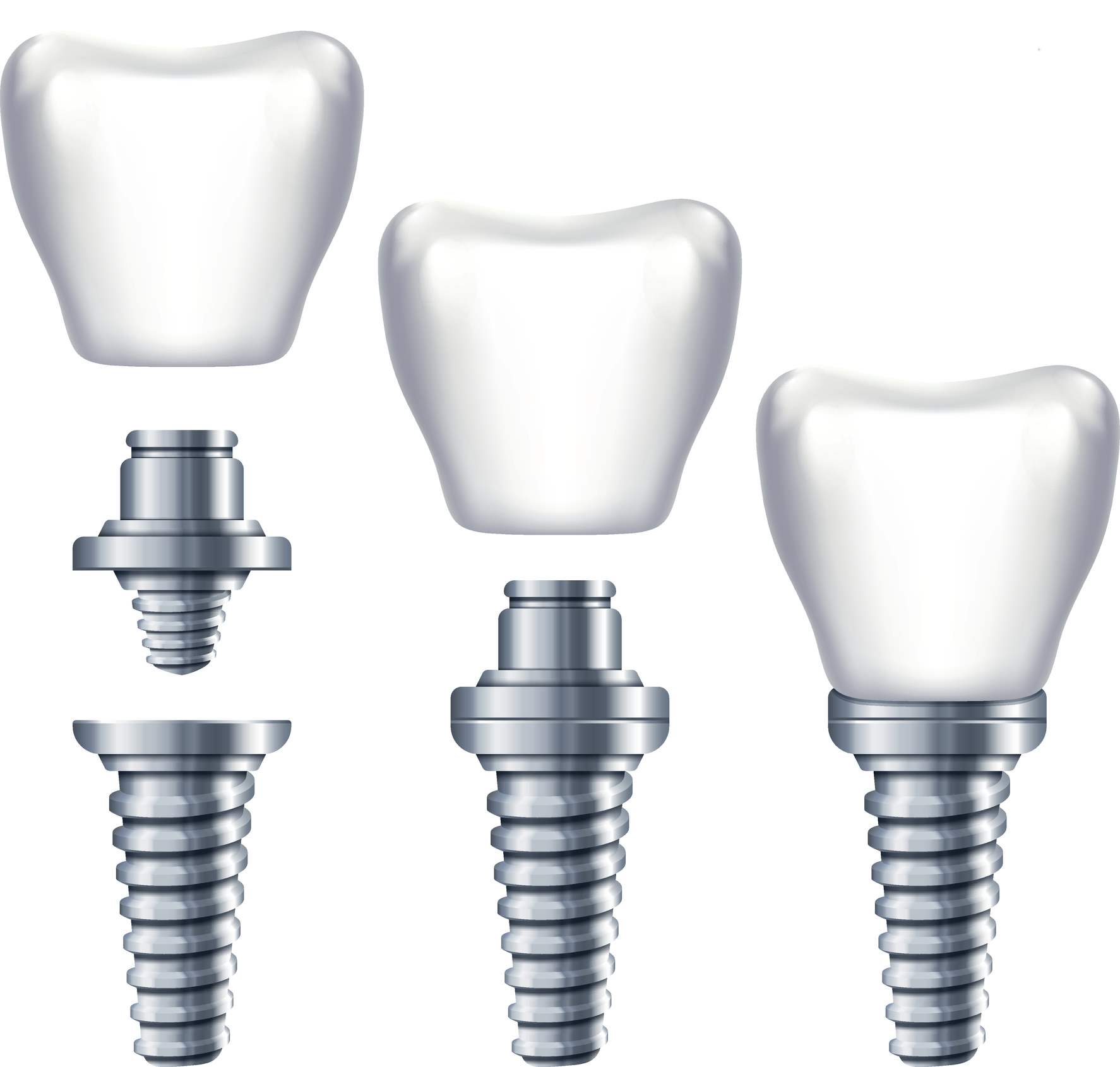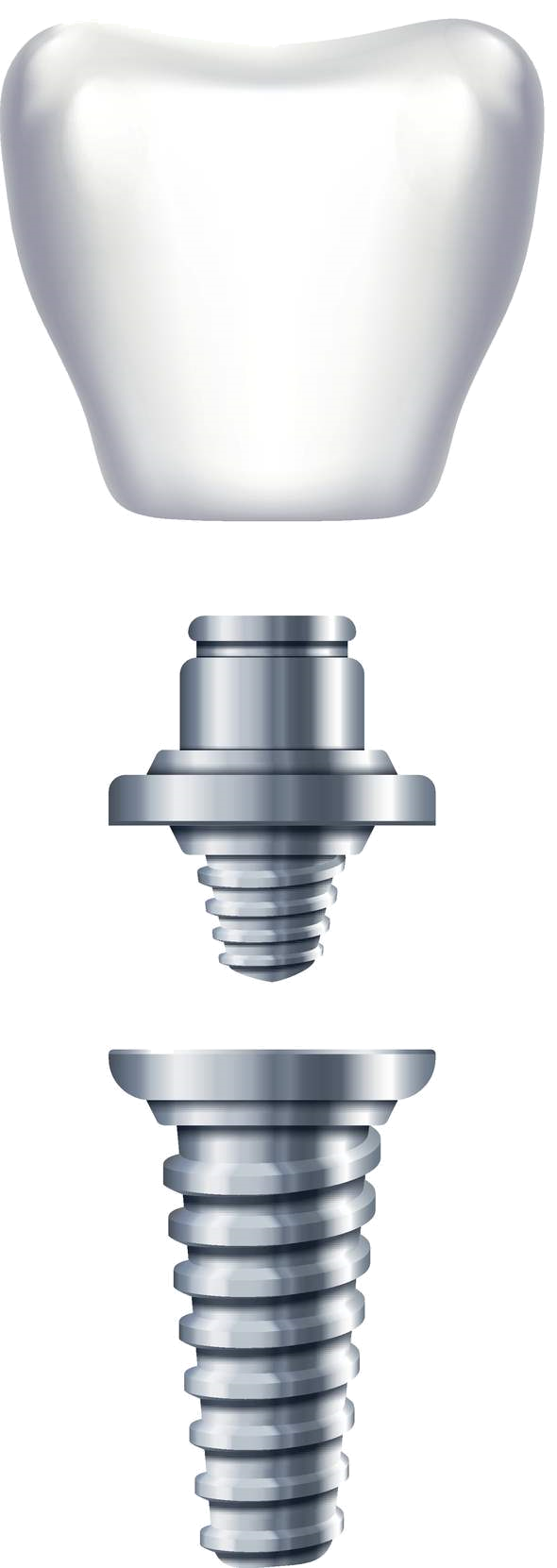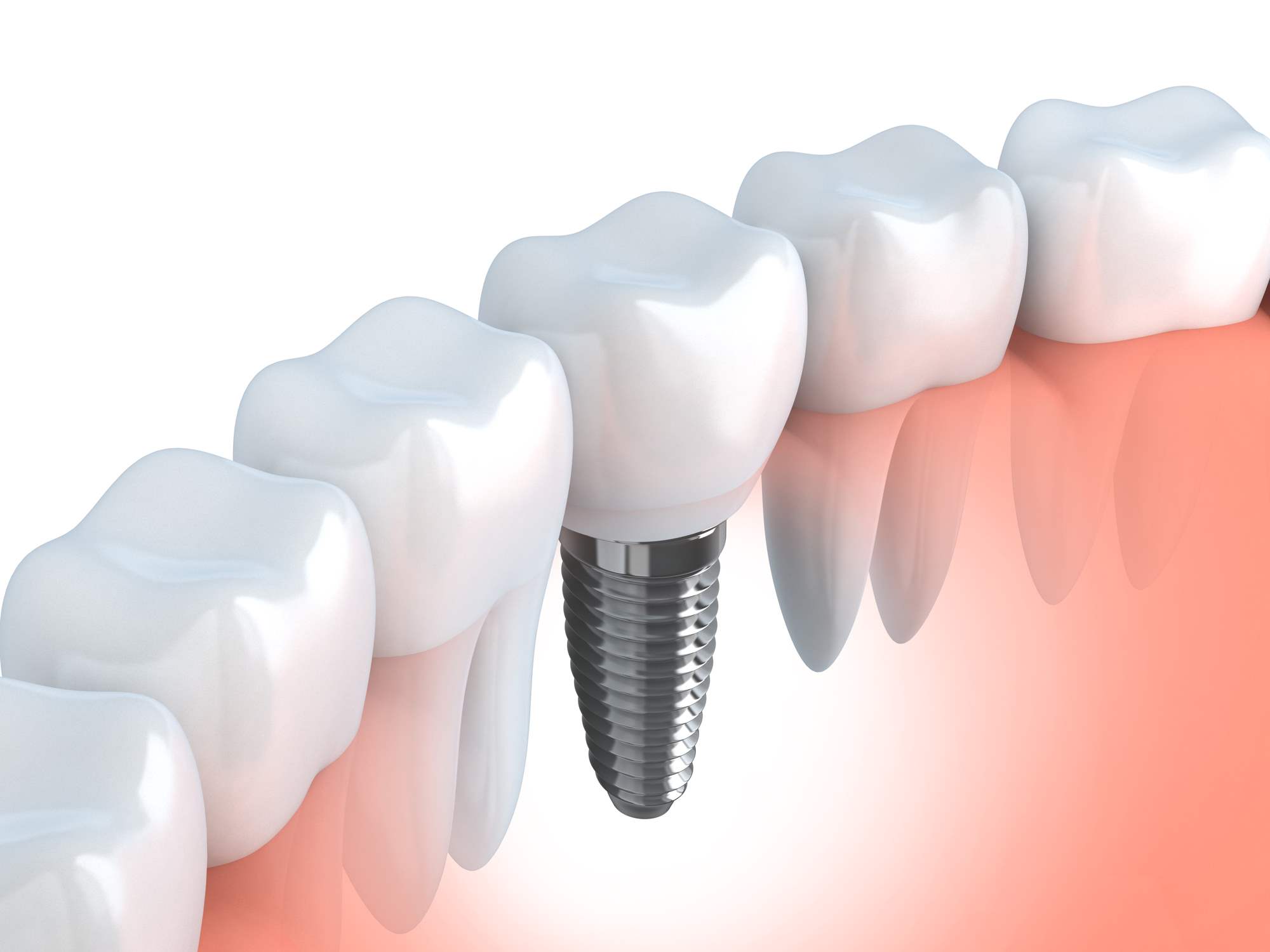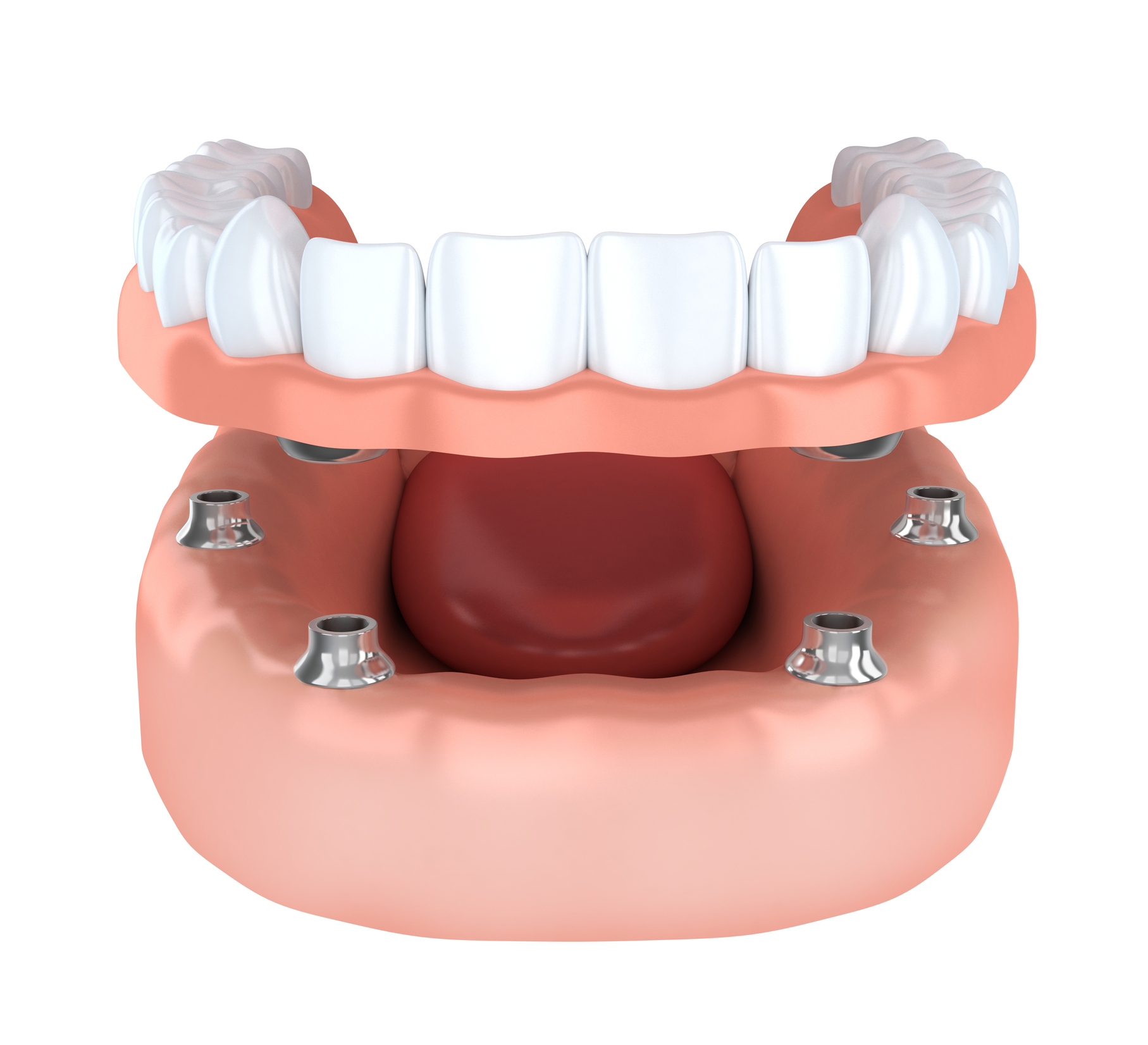IMPENDING TOOTH LOSS - AND NOW?
Evolution optimized our teeth for chewing, talking and for a winning smile. If the tooth cannot be preserved by endodontic treatment, a replacement as nature-identical as possible is the best solution. The tooth gap can be closed with either a “normal” bridge or an implant-supported denture. Replacing natural teeth is safest and most effective when using an artificial tooth root, the implant. It finds a firm hold in your bone and is firmly connected to the dentures (e.g. the crown): natural, without any foreign body sensation, with the same chewing and speaking functions that you were used to from your natural tooth.

“Every year, approx. 12.7 million teeth are being extracted in Germany!”
Gaps caused by tooth loss are closed with the help of implants, without the adjacent teeth being ground and damaged. Prostheses can also be anchored with dental implants so that they have a secure fit; when biting, laughing and playing sports! Like the natural, the artificial tooth, the implant, must be firmly anchored in the bone. Since this usually deteriorates after tooth loss, the shrunken “foundation” should be rebuilt before implantation, i.e. a bone base be created, which provides for the artificial tooth a firm and lasting support.
For us, as specialists in implantology, there are two things to do: First, to ensure a permanently good bone foundation, second, to place the implant optimally in such a way that the intended prosthetic restoration can be optimally integrated, and you will feel no difference between the natural and the artificial tooth.
Your team of the dental office Dr. med. Sikomed

Evolution optimized our teeth for chewing, talking and for a winning smile. If the tooth cannot be preserved by endodontic treatment, a replacement as nature-identical as possible is the best solution. The tooth gap can be closed with either a “normal” bridge or an implant-supported denture. Replacing natural teeth is safest and most effective when using an artificial tooth root, the implant. It finds a firm hold in your bone and is firmly connected to the dentures (e.g. the crown): natural, without any foreign body sensation, with the same chewing and speaking functions that you were used to from your natural tooth.
“Every year, approx. 12.7 million teeth are being extracted in Germany!”
Gaps caused by tooth loss are closed with the help of implants, without the adjacent teeth being ground and damaged. Prostheses can also be anchored with dental implants so that they have a secure fit; when biting, laughing and playing sports! Like the natural, the artificial tooth, the implant, must be firmly anchored in the bone. Since this usually deteriorates after tooth loss, the shrunken “foundation” should be rebuilt before implantation, i.e. a bone base be created, which provides for the artificial tooth a firm and lasting support.
For us, as specialists in implantology, there are two things to do: First, to ensure a permanently good bone foundation, second, to place the implant optimally in such a way that the intended prosthetic restoration can be optimally integrated, and you will feel no difference between the natural and the artificial tooth.
Your team of the dental office Dr. med. Sikomed

BRIDGE VS. IMPLANT
Nothing is better than the natural tooth. Therefore, as possible, this should be conserved. If retention of the tooth is not possible, the gap created by the extraction should be closed to maintain the functionality of your dentition unrestricted. Either implant-supported prosthetics or a bridge can be used for this purpose. The pros and cons of the individual restoration options can be found in the overview below.
BRIDGE
ADVANTAGES
DISADVANTAGES
BRIDGE
ADVANTAGES
DISADVANTAGES
IMPLANT
IMPLANTAT
ADVANTAGES
DISADVANTAGES
IMPLANTAT
ADVANTAGES
DISADVANTAGES
Since the implant comes closest to the natural tooth, you do not feel it and it is not visible to your counterpart. We have summarised all the information you need on this page.
COMPONENTS OF THE IMPLANT RESTORATION
Die implantologische Versorgung basiert auf drei Elementen:
Implant
Dental implants are small, technically mature artificial roots, usually titanium screws, which are anchored in the jaw like the natural tooth root and firmly fused with the jawbone. Like the natural root of the tooth, they serve to support the tooth crown that has been individually created for you.
Implant Abutment
The implant abutment represents the link between the implant and the tooth crown. It is, therefore, a kind of “adapter”.
Dental Crown
The dental crown is fixed on the implant after completion of the healing phase of the implant (about 3 to 6 months) and, if you opt for a ceramic crown, can no longer be distinguished from the natural adjacent teeth. If larger gaps are to be filled or the entire jaw is restored, bridges or prostheses are used instead of the single crown. These are fixed by several implants in the jawbone.

BEST REQUIREMENTS FOR OPTIMUM RESTORATION
BONE RESTORATION
What does not fit, is made to fit!
As oral and maxillofacial surgeons, we are specialists in bone restoration. For this purpose, we prefer to use the body’s own tissue, which we gain when we prepare the jawbone for insertion of the implant. This is the best basis for bone augmentation. The tissue is processed and placed where it is needed. For this purpose, different, tailored to your individual situation techniques are used. If insufficient body-own bone can be obtained from the surgical area, it can either be taken from other parts of the body or else be treated with “bone substitute material”. To restore bones, a variety of different and proven procedures can be used, which we routinely use in our office: according to individual diagnosis and to the aim of the procedure. Even bone deficits in the lateral upper jaw, which would prevent implantation, e.g. can be compensated with the so-called sinus lift. Here, the maxillary sinus floor is raised together with the mucous membrane and the cavity that forms is filled with bone or bone substitute material.
3D PLANNING
Why plan two-dimensionally when the surgery is performed three-dimensionally?
If the “artificial tooth” is to replace the natural tooth as completely as possible, it has to be as completely as possible identical to its location, size and appearance. In order to achieve this goal, implant planning must begin with the result, i.e. the location and dimensioning of the artificial tooth, as planned by your dentist. From this final position and the appearance of the denture then all those specifications are derived, which determine the insertion angle, size and length of the implant. In addition, the design and strength of your jaw bone and e.g. the course of the nerves must be considered. So, it’s about information in all three dimensions – length, width and depth. In order to optimally plan, we, therefore, use an X-ray technique, which shows all dimensions, meaning, it provides a three-dimensional image of your jaw, which is the basis of surgery and implant planning. This allows us to make the best possible use of the existing bone supply and to align the implants so precisely that an optimal prosthetic restoration is guaranteed.
The 3D X-ray is, thus, the method of choice to
- optimally use the bone substance
- increase the safety of the surgery, as nerves and other sensitive tissues are detected and protected in their three-dimensional position
- optimally synchronise the implant and prosthetic planning
- perform the surgery as gently as possible.
TREATMENT PROCEDURE

1
2
3
IMPLANT INSERTION
In our dental office, implant restoration is a routine procedure that takes little time. Due to the selected anesthetic, the treatment is completely painless for you. However, if you do not want to experience the minimal procedure, we can also treat you in semi-sedation or under general anesthesia.
Due to the precise planning of the implantation, where the artificial tooth root (implant) is implanted into the jawbone, often only a small incision in the gum is required. Opening the gum allows us to prepare the implant bed and insert the small screw into the bone.
HEALING PHASE
Immediately after the implant placement, bone healing processes begin in the jaw. The gentler the procedure is done, the faster and safer is healing process. The implant materials we use have a very high biocompatibility, so that the newly forming bone cells attach themselves directly to the implant and over time close it as tight as a natural tooth root. This integration process lasts, depending on the initial situation, about 10 to 20 weeks.
PROVISION OF NEW TEETH
Once the healing in the jawbone has been completed, we screw a special coping onto the implant so that the gum naturally forms and attaches tightly to the new tooth crown. About 14 days after the procedure, the coping is removed; it is replaced by a post (implant abutment). With it, your dentist then connects the individually manufactured dentures. Implant and dentures provide the optimal replica of the natural tooth so that you can eat and laugh without foreign body feeling and restriction.
IMPLANT INSERTION
In our dental office, implant restoration is a routine procedure that takes little time. Due to the selected anesthetic, the treatment is completely painless for you. However, if you do not want to experience the minimal procedure, we can also treat you in semi-sedation or under general anesthesia.
Due to the precise planning of the implantation, where the artificial tooth root (implant) is implanted into the jawbone, often only a small incision in the gum is required. Opening the gum allows us to prepare the implant bed and insert the small screw into the bone.
HEALING PHASE
Immediately after the implant placement, bone healing processes begin in the jaw. The gentler the procedure is done, the faster and safer is healing process. The implant materials we use have a very high biocompatibility, so that the newly forming bone cells attach themselves directly to the implant and over time close it as tight as a natural tooth root. This integration process lasts, depending on the initial situation, about 10 to 20 weeks.
PROVISION OF NEW TEETH
Once the healing in the jawbone has been completed, we screw a special coping onto the implant so that the gum naturally forms and attaches tightly to the new tooth crown. About 14 days after the procedure, the coping is removed; it is replaced by a post (implant abutment). With it, your dentist then connects the individually manufactured dentures. Implant and dentures provide the optimal replica of the natural tooth so that you can eat and laugh without foreign body feeling and restriction.
Single crown
Bridge
Full prothesis

Single Crown

Bridge

Full prothesis
MY RECOMMENDATIONS TO YOU

DR. THOMAS SIKOMED
IMPLANT RESTORATION SHOULD BE PREFERRED TO A BRIDGE SUPPLY AS A GENERAL RULE FOR THE FOLLOWING REASONS:
STATEMENTS OF PATIENTS
Source: Jameda.de
Great doctor!
I am very grateful to Dr. Sikomed for the sensitive treatment. I was incredibly nervous before, but he was able to take away my fear by explaining everything to me.
I can only recommend this dental office!
Thanks to the whole team in the dental office. I felt very comfortable there and I can recommend it to others.
Great dental office
I consulted the office of Dr. Sikomed, because I had the suspicion that something is wrong with my gums. I felt very comfortable there. Due to the local anesthesia, I experienced no pain.
WHEN WILL WE GET TO KNOW YOU?
WHY DON’T YOU MAKE AN APPOINTMENT!
Sikomed GmbH
Düstere-Eichen-Weg 35
37073 Göttingen
Telephone: 0551 998580
Telefax: 0551 9985899
E-Mail: info@sikomed.com


